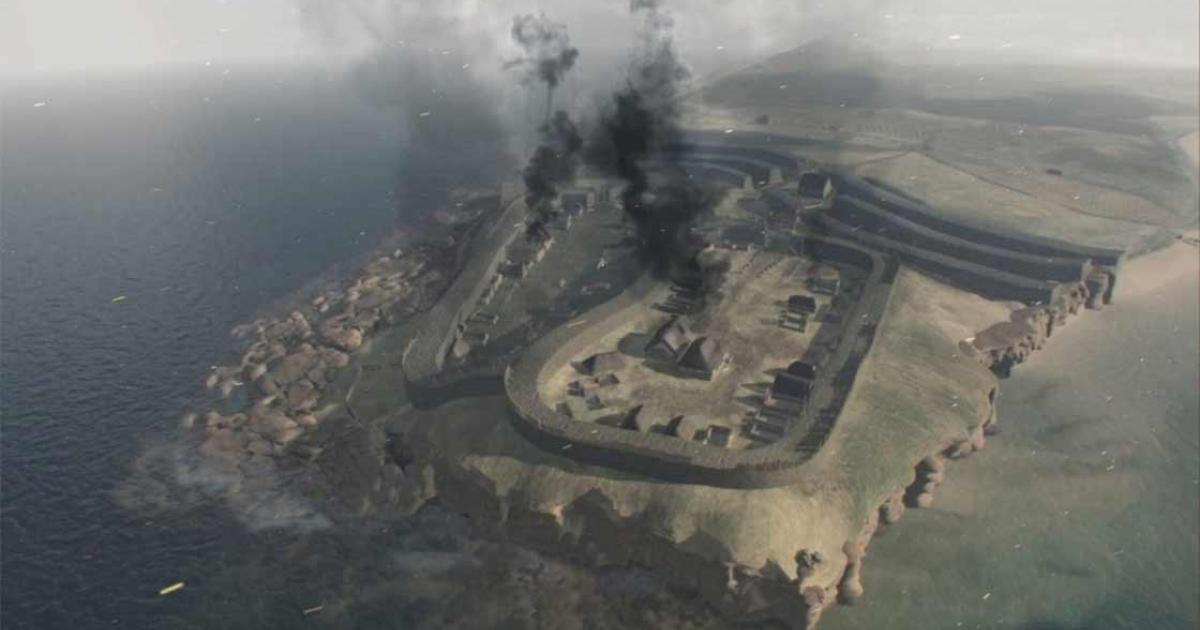
Bringing History to Life: Immense Pictish Fort is Reconstructed in 3D
Scottish archaeologists have released a mind-boggling 3D reconstruction of the largest royal Pictish fort ever discovered. Burghead Fort was the largest settlement of northern Picts in what is today Scotland, located on a promontory in the Moray Firth at the modern village of Burghead.
According to Burghead.com, in the 19th century archaeologists unearthed the foundations of a 6 meter (20 foot) high and 8 meter (26 foot) thick rampart, a defensive stone wall that surrounded the site.
Radiocarbon dating placed the fort to around 400 AD, and charcoal samples revealed that this vast defensive structure was destroyed by fire in the 9th or 10th century AD, likely by Viking sea raiders.
The 19th century archaeologists excavated some 30 stone panels, dated to the 5th century and decorated with images of bulls. It is thought that these were set into the massive ramparts of the fort, to enhance the location's perceived strength and aggression.
Moreover, because of the skill with which the bulls were carved it is generally accepted that this was an important Royal center in the early historic period.
Pictish-Christian Architecture
A team of archaeologists and visual scientists from the University of Aberdeen have now brought the ancient fort back to life in a stunning 3D reconstruction. A report in the Daily Mail says recent digs and the reconstruction yields ‘some of the most significant Pictish items and building remains ever uncovered.'
- Does the Fierce Reputation of The Picts Reflect Reality?
- Britain’s “Best Preserved Pictish Homes” Studied in Caithness
Among the most significant features discovered were the remains of a chapel at the entrance to the fort, and also an elaborate well, the top of which can still be seen today at the site. This combination of Pictish and Christian architecture is rare.

The fort, then and now (University of Aberdeen)
Kevin Grant, archaeology manager for Historic Environment Scotland, told the Daily Mail that the Burghead fort was one of “the most important places in Early Medieval Scotland” and that “it was specifically built to be dramatic and imposing.”
According to Grant, the discovery of the chapel at the fort, which is three times the size of any other enclosed site in Early Medieval Scotland, “reflects fascinating evidence of early Christian occupation.”
The Conversion Of The Picts
A great deal is known about Scotland’s first Neolithic settlers who spread north around 5,000 BC. However, much less is understood about the people of Caledonia before the Roman invasion of the 1st century and the eventual arrival of Christianity in the 4th century.
From the early 5th century, we see evidence that the Christianized Picts at Burghead slowly transitioned to the new religion. Their old agricultural trinities became worshiped in their new guise as the father, son and holy ghost.
For the next 500 years the people of Burghead farmed and fished the entire Moray coast and enjoyed an abundance of resources. However, the fort’s strategic and bounty rich location was to make it a target for Viking raiders plundering the northern Scottish coast in the 10th century, and it was destroyed by fire at this time.
Bringing The Pictish Fort to Life
University of Aberdeen archaeologist Gordon Noble says the recent excavations and resulting visualization “is transforming our understanding of Pictish Scotland and saving important archaeological remains from being lost to the waves.”
- Millennium Old Structure Unearthed at Medieval Pictish Fort in Scotland
- Ice Age Scotland Recreated In “Incredible” New Film
Furthermore, the lead archaeologist said the discovery of many artifacts demonstrate evidence of “metalworking and weaponry manufacture,” and hair and dress pins reveal secrets about Pictish fashion and trends.

The Picts were fierce warriors (Iantresman / Public Domain)
So archaeologically rich is this fort, Professor Noble said even the midden (rubbish) layers are provided “startling insights” into the lives of the Picts. Even the tiniest discoveries have tales to tell of the day to day lives of Burghead's farmers and fisherfolk, who inhabited the fort between the 6th and 10th centuries AD.
But it is in the brilliant new 3D reconstruction that the fort truly comes to live. By allowing viewers to step inside the fort as it was, it reveals secrets about the early medieval community’s functional space. This project points the way for the future of archaeology, where hands-on traditional digging meets advanced 3D visualization technologies.
Top Image: The reconstruction of the Pictish fort. Source: University of Aberdeen
By Ashley Cowie
















Comments
You can disagree all you want. But until you provide some reputable evidence, you're just telling us your half baked ideas.
Crasslee
Mr Wagner.
It's not my responsibility to disprove your fantastical ideas. Extraordinary claims require extraordinary evidence” was a phrase made popular by Carl Sagan who reworded Laplace's principle, which says that “the weight of evidence for an extraordinary claim must be proportioned to its strangeness” (Gillispie et al., 1999). So I'd say it's your responsibility to provide the evidence to back up your claims. So please provide the links to the peer reviewed journals that contain the research proving your ideas.
Crasslee
Scotland was under a couple of miles of ice in the iceage, so your idea for this site isn't possible.
I have an idea for you Mr Wagner. Maybe start submitting your own articles on Ancient Origins instead of continually making ill informed comments on others well researched articles.
Crasslee